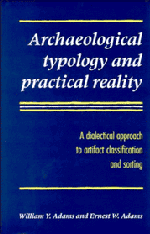 Archaeological Typology and Practical Reality
Archaeological Typology and Practical Reality Book contents
- Frontmatter
- Contents
- List of figures
- List of tables
- The archaeologist's preface
- The philosopher's preface
- PART I Introductory
- PART II The nature of types and typologies
- PART III Typology in action: the Medieval Nubian Pottery Typology
- PART IV Pragmatics of archaeological typology
- PART V Classification, explanation, and theory
- Appendices
- References
- Index
The archaeologist's preface
Published online by Cambridge University Press: 23 November 2009
- Frontmatter
- Contents
- List of figures
- List of tables
- The archaeologist's preface
- The philosopher's preface
- PART I Introductory
- PART II The nature of types and typologies
- PART III Typology in action: the Medieval Nubian Pottery Typology
- PART IV Pragmatics of archaeological typology
- PART V Classification, explanation, and theory
- Appendices
- References
- Index
Summary
For better or worse, this book represents something of an experiment. It is, so far as we know, one of the first attempts to achieve a genuine, two-way dialogue between archaeology and philosophy – the respective fields of its two authors. (For a predecessor – not concerned specifically with classification – see Kelley and Hanen 1988.)
It has been a common practice in recent years for archaeologists to borrow concepts and analytical tools from the philosophy of science, and apply them to their own field of endeavor (cf. Fritz and Plog 1970; Martin 1971; Watson, LeBlanc, and Redman 1971; Hill and Evans 1972; Kelley and Hanen 1988). However, this usage has often been both selective and uncritical. That is, the archaeologists have borrowed certain tools while ignoring others, and they have frequently overlooked the fact that the concepts they borrowed were the subject of controversy within the field of philosophy itself (cf. Kelley and Hanen 1988; WYA n.d. 2). Moreover, and more importantly, communication was strictly in one direction: from philosophy to archaeology.
In the present book we have tried to initiate a more genuine dialogue. We believe that, if the archaeologist has much to learn from the philosopher of science, the reverse is necessarily also true. In addition to applying philosophical concepts to the practice of archaeology, therefore, we have tried at various points to show how the practices of the field archaeologist reflect upon current controversies and issues in the philosophy of science.
- Type
- Chapter
- Information
- Archaeological Typology and Practical RealityA Dialectical Approach to Artifact Classification and Sorting, pp. xv - xxiPublisher: Cambridge University PressPrint publication year: 1991


